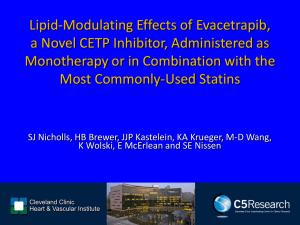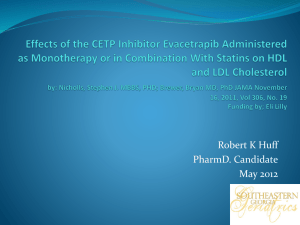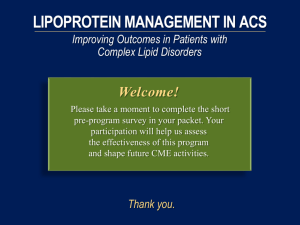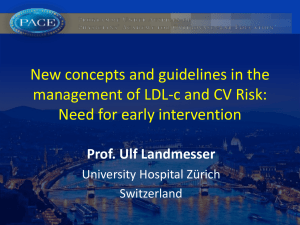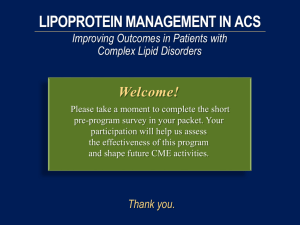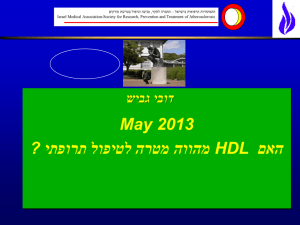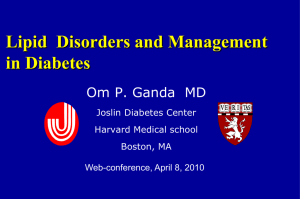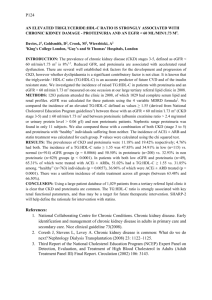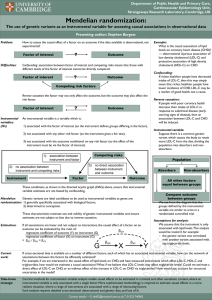PowerPoint
advertisement
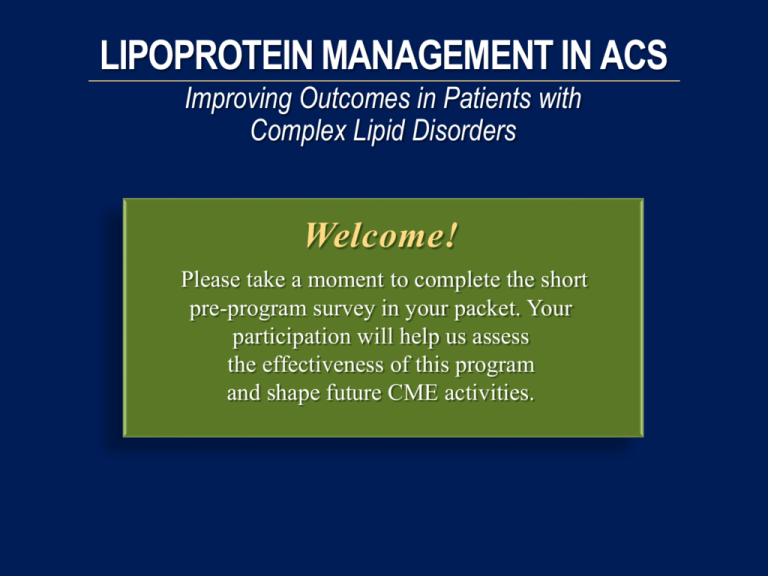
LIPOPROTEIN MANAGEMENT IN ACS Improving Outcomes in Patients with Complex Lipid Disorders Welcome! Please take a moment to complete the short pre-program survey in your packet. Your participation will help us assess the effectiveness of this program and shape future CME activities. LIPOPROTEIN MANAGEMENT IN ACS Improving Outcomes in Patients with Complex Lipid Disorders When filling out your evaluation form, please include your email address. Those participants who do will be invited by CE Outcomes, LLC within 5-6 weeks to participate in a short, follow-up survey to identify and address future educational needs. The first 50 respondents to the follow-up survey will receive an Amazon gift card from CE Outcomes. Thank you. Faculty Disclosures The faculty reported the following relevant financial relationships that they or their spouse/partner have with commercial interests: TO BE FILLED IN BY PRESENTING PHYSICIAN(S) • XXXXXXXXX, MD, FAHA, FNLA Consultant: Roche, Abbott, Amarin, Daiichi-Sankyo, GlaxoSmithKline, Merck, Atherotech, Essentialis; Speaker: Abbott, Daiichi-Sankyo, GlaxoSmithKline, Merck; Researcher: Abbott, Merck • XXXXXXXXX, MD, FACC, FAHA Nothing to disclose Steering Committee and Consultant Disclosures The Steering Committee and Curriculum Consultants reported the following relevant financial relationships that they or their spouse/partner have with commercial interests: • Michael Davidson, MD: Speakers’ Bureau: Abbott, AstraZeneca, GlaxoSmithKline, Merck; Advisory Board/Consultant: Abbott, Aegerion, Amgen, AstraZeneca, Atherotech, Daiichi-Sankyo, DTC MD, Esperion, GlaxoSmithKline, iMD (Intelligent Medical Decisions), Kinemed, LipoScience, Merck, Novo Nordisk, Roche, SanofiAventis, Synarc, Takeda, Vindico Medical Education; Grant Research: Abbott, Daiichi-Sankyo, GlaxoSmithKline, Merck, Roche; Board of Directors/Equity: DTC MD, Omthera, Professional Evaluation Inc., Sonogene • Peter P. Toth, MD, PhD: Speaker: Abbott, AstraZeneca, Merck, Takeda, GlaxoSmithKline, Boehringer-Ingelheim; Consultant: Abbott, AstraZeneca, Merck, Genentech, Genzyme; Advisory Board: Atherotek • William E. Boden, MD, FACC, FAHA: Speaker: Gilead, Abbott, Sanofi-Aventis, Kowa • Michael Miller, MD, FACC, FAHA: Nothing to Disclose Non-faculty Disclosures Non-faculty content contributors and/or reviewers reported the following relevant financial relationships that they or their spouse/partner have with commercial interests: • Barry Watkins, PhD; Bradley Pine; Blair St. Amand; Jay Katz; Dana Simpler, MD: Nothing to Disclose Educational Objectives At the conclusion of this activity, participants should be able to demonstrate the ability to: • Examine the need for comprehensive lipid management in dyslipidemic patients who sustain an ACS • Compare the relative effectiveness of existing treatments to raise HDL-C and reduce CVD risk • Explain the rationale for developing novel agents to increase HDL-C • Provide an overview of clinical trials evaluating efficacy and safety of emerging therapies to modulate HDL-C Key Learning Messages • Lowering LDL-C reduced CVD risk in patients with CAD • There is much residual CVD risk even with intense statin therapy • But half of ACS patients present with LDL-C of 100-120 mg/dL • Low HDL-C is an independent CVD risk factor • High HDL-C is antiatherogenic, antiinflammatory, antioxidant, antithrombotic • Should HDL-C be a target of therapy to reduce CVD risk? • Niacin and fibrates may increase HDL-C, but do not reduce CVD risk • CETP inhibitors may increase HDL-C and reduce CVD risk • Emerging CETP inhibitors are mechanistically diverse • HDL consists of heterogeneous particles, not all of which are functional • Functional HDL has high cholesterol efflux capacity • High cholesterol efflux capacity is associated with antiatherogenic effect Attributable Declines in CHD Deaths Attributable reduction in CHD deaths (%) Between 1980 and 2000 Net 44% ↑TG,↓HDL-C Target Population 47% Therapies Ford ES et al. N Engl J Med. 2007;356:2389-2398. Lifestyle/RFs Unexplained Lowering LDL-C Reduces CVD Risk in Patients with CAD Cardiovascular Risk Increases with Increased Plasma Apo B Lipoproteins Rationale for therapeutic lowering of Apo B lipoproteins: decrease the probability of inflammatory response to retention Apo B lipoprotein particles Blood Monocytes bind to adhesion molecules Smooth muscle Inflammatory response Modification Macrophage Foam cell Tabas I et al. Circulation. 2007;116:1832-1844. Williams KJ et al. Arterioscler Thromb Vasc Biol. 1995;15:551-561. Hoshiga M et al. Circ Res. 1995;77:1129-1135. Williams KJ et al. Arterioscler Thromb Vasc Biol. 2005;25:1536-1540. Merrilees MJ et al. J Vasc Res. 1993;30:293-302. Nakata A et al. Circulation.1996;94:2778-2786. Steinberg D et al. N Engl J Med. 1989;320:915-924. CHD Event Rates in Secondary Prevention and ACS Statin Trials 30 y = 0.1629x · 4.6776 R² = 0.9029 P <0.0001 CHD Events (%) 25 4S-P 20 HPS-P 15 HPS-S A2Z 20 A2Z 80 10 PROVE-IT-AT 5 LIPID-P 4S-S CARE-P TNT 10 LIPID-S IDEAL S20/40 TNT 80 CARE-S IDEAL A80 PROVE-IT-PR 0 30 50 70 90 110 130 150 LDL Cholesterol (mg/dL) Updated from O’Keefe J et al. J Am Coll Cardiol. 2004;43:2142-46. 170 190 210 There is Much Residual CVD Risk, Even with Intense Statin Therapy Reduction in Major Coronary Events in Major Statin Trials by Level of Patient Risk Primary AF/ TexCAPS 6605 -27% Trial N LDL-C WOSCOPS 6595 -26% Secondary High Risk ASCOT 10,305 -28% HPS 20,536 -29% 4S 4444 -36% LIPID 9014 -25% CARE 4159 -28% Risk Reduction, (%) 0 -20 -31* -40 -38* -25* -27‡ -36† -25§ -38* Major coronary events defined as: fatal or nonfatal myocardial infarction (MI), unstable angina, sudden cardiac death in AF/TexCAPS; nonfatal MI or coronary death in WOSCOPS, ASCOT, HPS, LIPID, CARE; coronary death, nonfatal MI, silent MI, resuscitated cardiac arrest in 4S. *P<0.001; †P=0.0005; ‡P<0.0001; §P=0.002 LaRosa J et al. JAMA. 1999;282:2340-2346; HPS Collaborative Group. Lancet. 2002;360:7-22; Sever PS et al. Lancet. 2003;361:1149-1158. Residual CVD Risk in Statin vs Placebo Trials CHD Events Occur in Patients Treated with Statins Patients Experiencing Major CHD Events, % 40 30 20 28.0 Placebo Statin 19.4 15.9 12.3 10 0 N LDL 4S1 4S 4444 -35% LIPID2 LIPID 9014 -25% Secondary Group. Lancet. 1994;344:1383-1389. Study Group. N Engl J Med. 1998;339:1349-1357. 3Sacks FM et al. N Engl J Med. 1996;335:1001-1009. 13.2 10.2 CARE3 CARE 4159 -28% 11.8 8.7 HPS4 HPS 20 536 -29% High Risk 14S 4HPS 2LIPID 5Shepherd 7.9 10.9 5.5 6.8 WOSCOPS5 AFCAPS/TexCAPS6 AFCAPS WOS 6595 6605 / TexCAPS -26% -25% Primary Collaborative Group. Lancet. 2002;360:7-22. J et al. N Engl J Med. 1995;333:1301-1307. 6 Downs JR et al. JAMA. 1998;279:1615-1622. Residual CVD Risk in Patients Treated with Intensive Statin Therapy Remains Unacceptably High 40 Statistically significant, but clinically inadequate CVD reduction1 Patients Experiencing Major CVD Events, % 30 20 13.7 12.0 10 0 2 PROVEIT-TIMI IT-TIMI 22 PROVE 22 4162 95 62 HR. Br J Cardiol. 2006;13:131-136. CP et al. N Engl J Med. 2004;350:1495-1504. 3Pedersen TR et al. JAMA. 2005;294:2437-2445. 4LaRosa JC et al. N Engl J Med. 2005;352:1425-1435. 2Cannon Standard statin therapy Intensive high-dose statin therapy 22.4 n LDL-C* mg/dL 1Superko 26.3 IDEAL3 IDEAL 8888 104 81 10.9 8.7 TNT4 TNT 10,001 101 77 *Mean or median LDL-C after treatment JUPITER Primary Trial Endpoint MI, Stroke, UA/Revascularization, CV Death 0.08 Placebo 251 / 8901 0.04 - 44 % Rosuvastatin 142 / 8901 0.00 0.02 Cumulative Incidence 0.06 HR 0.56, 95% CI 0.46-0.69 P < 0.00001 Number Needed to Treat (NNT5) = 25 0 1 2 Follow-up (years) Number at Risk Rosuvastatin Placebo 8,901 8,901 8,631 8,621 8,412 8,353 6,540 6,508 3,893 3,872 1,958 1,963 3 1,353 1,333 4 983 955 544 534 157 174 A Case of Residual CVD Risk • Patient Profile: 58-year-old white male – Known CAD (preclinical) – BMI 27 – LDL-C 67 mg/dL – Triglycerides 300 mg/dL – HDL-C 32 mg/dL – Treadmill stress test: achieved target heart rate without angina/ischemia • Medications – Statin, blood pressure medication, aspirin • Does this patient require additional treatment? If so, what? Grady D. A Search for Answers in Russert’s Death. The New York Times. June 17, 2008. Johnson A. NBC’s Tim Russert Dies of a Heart Attack at 58. NBC News and msnbc.com. June 14, 2008. Tim Russert: Residual CVD Risk • April 2008 – Known CAD (preclinical) – BMI 27 – LDL-C 67 mg/dL; Triglycerides 300 mg/dL; HDL-C 32 mg/dL – Treadmill stress test: achieved target heart rate without angina/ ischemia • June 2008 – AMI at work – Attempts to resuscitate fail • Could this have been avoided? Grady D. A Search for Answers in Russert’s Death. The New York Times. June 17, 2008. Johnson A. NBC’s Tim Russert Dies of a Heart Attack at 58. NBC News and msnbc.com. June 14, 2008. Annual CHD Event Rate Based on the Framingham Risk Score FRAMINGHAM RISK FACTORS Mr. Russert: Age: 58 Gender: male Total cholesterol: 150mg/dL HDL cholesterol: 32 mg/dL Smoker: no Systolic BP: 120 On HBP meds: yes TEN YEAR RISK SCORE: 10% Braunwald E. J Am Coll Cardiol. 2006;47(8 Suppl):C101-C103. Wood D et al. Eur Heart J. 1998;19:A12-A19. CAD Hospitalization and Temporal Trends In Lipid Levels from 2000-2006 (Mean) Sachdeva A et al. Am Heart J. 2009;157:111-117.e2. Lifetime Risk for CVD Increases With Greater Risk Factor Burden Lifetime Risk for CVD, % 80 Risk Factor Burden at Age 50 (Estimated Risk by Age 95) 69 70 60 46 50 36 40 10 0 39 50 Women Men 39 27 30 20 50 8 5 All Optimal ≥1 Not Optimal ≥1 Elevated 1 Major ≥2 Major Lifetime burden stratified for risk factor burden years among Framingham Heart Study participants free of CVD at 50 years. Optimal risk factors defined as total cholesterol <180 mg/dL, BP <120/<80 mmHg, nonsmoker, and nondiabetic. Nonoptimal risk factors are defined as total cholesterol 180–199 mg/dL, systolic BP 120–139 mmHg, diastolic BP 80–89 mmHg, nonsmoker, and nondiabetic. Elevated risk factors are defined as total cholesterol 200–239 mg/dL, systolic BP 140–159 mmHg, diastolic BP 90–99 mmHg, nonsmoker, and nondiabetic. Major risk factors are defined as total cholesterol ≥240 mg/dL, systolic BP ≥160 mmHg, diastolic BP ≥100 mmHg, smoker, and diabetic. CVD = cardiovascular disease; BP = blood pressure. Lloyd-Jones DM et al. Circulation. 2006;113:791-798. Lowering LDL-C Alone only Moderately Reduces CHD Risk • Major statin trials consistently show an approximate 25%-40% risk reduction for cardiovascular events, regardless of baseline LDL-C levels1,2 • Despite on-therapy LDL-C <80 mg/dL, a significant number of ACS patients still have events3,4 • Even with aggressive LDL-C lowering, residual risk remains high for at least 2 years following an index event, since 2/3-3/4 of CHD events are not avoided1 • There is a great need for further improvement in cardiovascular risk reduction5 CHD = coronary heart disease 1. LaRosa J et al. JAMA. 1999;282:2340-2346. 2. HPS Collaborative Group. Lancet. 2002;360:7-22. 3. Cannon CP et al. N Engl J Med. 2004;350:1495-1504. 4. de Lemos JA et al. JAMA. 2004;292:1307-1316. 5. Assmann G, Gotto AM Jr. Circulation. 2004;109(suppl III):8-14. Low HDL-C is an Independent CVD Risk Factor Circulating Lipoproteins Play a Major Role in Atherosclerosis LDL HDL ApoB* ApoAI ApoB-containing lipoproteins1 ApoAI-containing lipoproteins1 Non-HDL (atherogenic) – LDL – IDL – VLDL /VLDL remnants – Chylomicron remnants – Lp(a) HDL (antiatherogenic) – α-HDL – Pre-β HDL *ApoB is a component of all lipoprotein particles currently considered atherogenic 2 Apo = apolipoprotein; IDL = intermediate-density lipoprotein; VLDL = very low-density lipoprotein; Lp(a) = lipoprotein (a) 1. Olofsson SO et al. Vasc Health Risk Manag. 2007;3:491-502. 2. Grundy SM. Circulation. 2002;106:2526-2529. 3. Kunitake ST et al. J Lipid Res. 1992;33:1807-1816. Images available at: http://www.mc.vanderbilt.edu/lens/article/?id=186&pg=999. Accessed January 2010. Adapted with permission. Framingham Heart Study Low HDL-C Predicts CHD Independent of LDL-C CAD Risk After 4 Years* HDL-C is inversely correlated with CAD risk Correlation is independent of LDL-C 3 2 1 25 45 65 0 85 100 *Men aged 50-70 years Castelli W. Can J Cardiol. 1988;4(suppl A):5a-10a. 160 220 LDL-C, mg/dL HDL-C mg/dL CHD Risk According to HDL-C Levels The Framingham Heart Study CHD risk ratio 4.0 4.0 3.0 2.0 1.0 2.0 1.0 0 25 45 65 HDL-C (mg/dL) Kannel WB. Am J Cardiol 1983;52:9B-12B. Copyright ©1983, with permission from Excerpta Medica Inc. Early and Late Mortality Post-DES Low LDL-C versus High HDL-C at Baseline Wolfram RM et al. Am J Cardiol. 2006;98:711-717. High HDL-C Levels Reduce CVD Risk High levels of HDL-C are Anti-atherogenic, Anti-inflammatory, Anti-oxidant, and Antithrombotic Residual CVD Risk: TNT Study HDL-C Inversely Predictive of Risk Even at LDL-C <70 mg/dL 10 Hazard ratio (95% CI) vs Q1 Q2 0.85 (0.57 - 1.25) Q3 0.57 (0.36 - 0.88) Q4 0.55 (0.35 - 0.86) Q5 0.61 (0.38 - 0.97) 9 8 7 6 5 4 3 2 1 0 Q1 (<37) Q2 (37 to <42) Q3 (42 to <47) Q4 (47 to <55) Quintile of HDL Cholesterol Level (mg/dl) Barter P et al. N Engl J Med. 2007;357:1301-1310. Q5 (≥55) Each 1 mg/dL increase in HDL-C decreases the risk of major CV events by approximately 1.1%, in models created both at baseline and at 3 months. Potential Antiatherogenic Actions of HDL-C HDL-C inhibits expression of endothelial cell adhesion molecules and MCP-1 Monocyte Vessel Lumen LDL-C MCP-1 Adhesion molecule Cytokines LDL-C Endothelium HDL-C inhibits oxidation of LDL-C Oxidized LDL-C Intima Foam cell Macrophage HDL-C promotes efflux of cholesterol from foam cells MCP-1 = monocyte chemoattractant protein-1 Adapted from Barter PJ et al. Circ Res. 2004;95:764-772. Should High-density Lipoprotein Be a Target of Therapy ? ATP III Guidelines on HDL-C: “Current documentation of risk reduction through controlled clinical trials is not sufficient to warrant setting a specific goal value for raising HDL-C” However, there are more clinical data to justify HDL-C as a therapeutic target in 2011 than there were for LDL-C in 1998. Grundy SM et al. Circulation. 2004;110:227-239. Effects of Lifestyle Modifications on HDL-C Levels • Weight Reduction − For every 3 kg (7 lb) of weight loss, HDL-C levels increase 1 mg/dL • Smoking Cessation − HDL-C levels in smokers are 7%-20% lower than those in nonsmokers − HDL-C levels return to normal within 30-60 days after smoking cessation • Exercise − Aerobic exercise (40 min, 3-4 times weekly) increases HDL-C by about 2.5 mg/dL Rössner S et al. Atherosclerosis. 1987;64:125-130. Wood PD et al. N Engl J Med. 1988;319:1173-1179. Cullen P et al. Eur Heart J. 1998;19:1632-1641. Kokkinos PF et al. Arch Intern Med. 1995;155:415-420. Kodama S et al. Arch Intern Med. 2007;167:999-1008. Reducing CAD Risk in Patients with Dyslipidemia Established LDL-C Strong Evidence HDL-C Triglycerides Not Established Lp(a) Homocysteine Oxidized LDL-C CRP Small dense LDL Coagulability Effects of Drugs on HDL-C Levels Nicotinic acid Fibrates Estrogens Statins α-blockers Alcohol ↑ ↑ ↑ ↑ ↑ ↑ 15%–35% 10%–15% 10%–15% 5%–10% 10%–20% 10% Belalcazar LM, Ballantyne CM. Prog Cardiovasc Dis. 1998;41:151-174. Risk Reduction for CHD Events As a Function of Changes in TC, LDL-C, and HDL-C PERCENT CHANGE *4S, CARE, LIPID, WOSCOPS **HELSINKI, VA-HIT,AFCAPS/TexCAPS CHD EVENT RATE Niacin and Fibrates May Increase HDL-C, but Do Not Consistently Reduce CVD Risk FIELD: Fenofibrate in People with DM Primary Outcome: CHD Events (CHD Death + Nonfatal MI) Cumulative risk (%) 10 8 Placebo Fenofibrate HR = 0.89 95% CI = 0.75–1.05 P=0.16 Although fenofibrate reduced triglycerides and LDL-C, there was virtually no increase shown in HDL 6 4 2 0 0 1 2 3 4 5 6 2541 2553 837 850 Years from randomisation FIELD Study 4900 investigators. Lancet. 2005;366:1849-1861. Placebo 4835 4741 4646 Fenofibrate 4895 4837 4745 4664 4547 4555 ACCORD Lipid: Results The combination of fenofibrate and simvastatin failed to reduce the risk of fatal CV events, nonfatal MI, or nonfatal stroke Primary and secondary outcomesa Outcome Fenofibrate (n=2765), %/y Placebo (n=2753), %/y Hazard ratio (95% CI) Primary outcome 2.24 2.41 0.92 (0.79–1.08) Primary outcome plus revascularization or hospitalization for CHFb 5.35 5.64 0.94 (0.85–1.05) Major coronary disease event 2.58 2.79 0.92 (0.79–1.07) Nonfatal MI 1.32 1.44 0.91 (0.74–1.12) Any stroke 0.38 0.36 1.05 (0.71–1.56) Nonfatal stroke 0.35 0.30 1.17 (0.76–1.78) Death from any cause 1.47 1.61 0.91 (0.75–1.10) Death from CV causes 0.72 0.83 0.86 (0.66–1.12) Fatal or nonfatal CHF 0.90 1.09 0.82 (0.65–1.05) a. At a median of 4.7 years b. CHF=congestive heart failure Ginsberg H. Presented at: ACC 2010 Scientific Sessions. AIM-HIGH • On-treatment lipids – 3414 men and women with vascular disease and HDL ≤40, TG 150-400, LDL-C ≤180 if statin naïve, <160 if on statin • Therapy – Simvastatin (40-80 mg) vs simvastatin (40 + niaspan 1500-2000 mg) • 1° Endpoints – CHD Death, nonfatal MI, ischemic stroke, high-risk ACS, hospitalization for coronary or cerebrovascular revascularization AIM-HIGH Terminated by Data Safety Monitoring Board: 36-month Follow-up • On-treatment Lipids – HDL-C ↑ 20% / TG ↓ 25% – Baseline LDL-C: 71 mg/dL • 1° Endpoints: Negative – 28 strokes (1.6%) on extended release niacin (ERN) – 12 strokes (0.7%) in control group – 9 of 28 strokes in ERN discontinued drug at least 2 months and up to 4 years before CVA • Study’s Drug Safety and Monitoring Board recommended early termination, due to “futility” or lack of efficacy and the stroke signal Press conference transcript; May 26, 2011. Available at: www.nhlbi.nih.gov/new/remark/aim-high-transcript.htm. CETP Inhibitors Increase HDL-C and May Reduce Atherosclerosis Role of CETP Inhibition in Atherosclerosis LDL-R LDL VLDL CE CETP Foam cells TG ABC-A1 RCT Bile LIVER HDL Atherosclerosis LDL ABC-G1 PLASMA Free cholesterol PERIPHERAL TISSUE • Human CETP deficiency is usually associated with marked ↑ in HDL-C • CETP activity is inversely correlated with plasma HDL-C • Decreasing CETP activity has consistently inhibited atherosclerosis in animal models Barter PJ et al. Arterioscler Thromb Vasc Biol. 2003;23:160-167. Contacos C et al. Atherosclerosis. 1998;141:87-98. Guerin M et al. Arterioscler Thromb Vasc Biol. 2008;28:148-154. Emerging CETP Inhibitors are Mechanistically Diverse CETP Inhibitors and Modulators Evacetrapib CETP Barter et al. N Engl J Med. 2007;357:2109-2122. Qiu et al. Nat Struct Mol Biol. 2007;14:106-112. http://www.ama-assn.org/ama1/pub/upload/mm/365/dalcetrapib.doc. http://www.ama-assn.org/ama1/pub/upload/mm/365/anacetrapib.pdf. http://www.ama-assn.org/ama1/pub/upload/mm/365/torcetrapib.doc. Torcetrapib “Beneficial” Effects on Lipoproteins +49% +55% +42% HDL-C LDL-C +1% +1% -1% Placebo 60 mg -18% -20% 90 mg 120 mg Is the toxicity of torcetrapib related to the mechanism or the molecule? Barter PJ et al. N Engl J Med. 2007;357:2109-2122. Torcetrapib Patients Without Event (%) BUT Increased Cardiovascular and Non-cardiovascular Morbidity and Mortality 100 Atorvastatin only 98 96 94 92 Torcetrapib plus atorvastatin 90 0 0 90 180 270 360 450 540 630 720 810 Days After Randomization Is the toxicity of torcetrapib related to the mechanism or the molecule? Barter PJ et al. N Engl J Med. 2007;357:2109-2122. Analysis of the Off-target Characteristics of Investigational CETP Inhibitors/Modulators Characteristic Torcetrapib Anacetrapib Dalcetrapib Evacetrapib Clinical evidence of increased BP Yes1 No2 No3 No7 Preclinical evidence of increased aldosterone production* Yes3 No4 No3 No8 Preclinical evidence of aldosterone synthase (CYP11B2) mRNA induction* Yes3 ? No3 ? Preclinical evidence of RAASassociated gene induction* Yes5 ? No5 ? L-type Ca2+ channel activation* Yes6 ? No6 ? 1. Barter et al. N Engl J Med. 2007;357:2109-2122. 3. Stein et al. Am J Cardiol. 2009;104:82-91. 5. Stroes et al. Br J Pharmacol. 2009;158:1763-1770. 7. Nicholls et al. JAMA 2011;306:2099-2109 2. Masson D. Curr Opin Invest Drugs. 2009;10:980-987. 4. Forrest et al. Br J Pharmacol. 2008;154:1465-1473. 6. Clerc et al. J Hypertens. 2010: in press. 8. Cao et al. J Lipid Research. 2011;52:2169-2176 Lipid Effects of CETP Inhibitors/Modulators % Change from Baseline CETP Agent Dose (Mg/day) HDH-C % LDL-C (%) TG (%) Torcetrapib 60 61 -24 -9 Anacetrapib 100 138 -40 -7 Evacetrapib 500 129 -36 -11 Dalcetrapib 600 31 -2 -3 Adapted from Cannon C et al. JAMA. 2011;306:2153-2155. Nicholls SJ et al. JAMA. 2011;306:2099-2109. Anacetrapib Effects on LDL-C and HDL-C LDL-C 100 100 -39.8% (P<0.001) HDL-C (mg/dL) (SE) LDL-C (mg/dL) (SE) 80 60 40 Anacetrapib Placebo 20 0 HDL-C 120 Baseline 6 12 18 24 80 +138.1% (P<0.001) 60 40 Anacetrapib Placebo 20 30 46 62 76 0 Baseline 6 12 18 24 30 46 62 76 Study Week Study Week Anacetrapib n = 804 771 716 687 646 604 568 540 Anacetrapib n = 776 757 718 687 647 607 572 543 Placebo n = 803 759 741 743 735 711 691 666 Placebo n = 766 761 741 744 736 711 691 666 Cannon CP et al. N Engl J Med. 2010;363:2406-2415. Dalcetrapib Phase IIb Trial HDL-C Increase at Week 12 Change From Baseline (%) *P <0.0001 vs placebo * * * placebo n = 73 dalcetrapib 300 mg n = 75 NOTE: Dalcetrapib 600 mg is the dose used in phase III Stein EA. Am J Cardiol. 2009;104:82-91. dalcetrapib 600 mg n = 67 dalcetrapib 900 mg n = 72 Dalcetrapib (JTT-705) Attenuates Atherosclerosis in Rabbits Okamoto H et al. Nature. 2000;406:203-207. Comparison of the Effect of CETP Agents on Serum HDL-C·AUC and Fecal Radioactivity 1000 HDL-C•AUC *P < 0.01 #P < 0.01 * Fecal [3H] total sterols * # 20 15 * # 10 500 5 0 0 Control Dalcetrapib Niesor EJ et al. J Lipid Res. 2010;51:3443-3454. Torcetrapib Anacetrapib Fecal [3H] Total Sterols (% of Injection) HDL-C·AUC (mg/dL/day) 1500 Dalcetrapib and Torcetrapib Differ in Mechanism by Which They Decrease CETP Activity dal HDL • Dalcetrapib binds to CETP, inducing a conformational change to CETP that hinders its further association to HDL1 • Dalcetrapib binds to CETP only2 CETP tor or ana HDL • Torcetrapib or anacetrapib binding to CETP results in a high affinity complex of CETP inhibitor, HDL, and CETP2,3 NB: The clinical relevance of these differences is unknown; these compounds have not been studied in head-to-head clinical trials. Therefore, no conclusion should be drawn based on these comparisons. Clinical development of torcetrapib was halted due to off-target adverse effects. 1Okamoto H et al. Nature. 2000;406:203-207. 3Clark RW et al. J Lipid Res. 2006;47:537-552. 2Niesor EJ et al. Atherosclerosis. 2008;199:231. HDL Consists of Heterogeneous Particles, but Their Clinical Relevance Remains to Be Established HDL Can Be Subdivided into Various Subpopulations Particle shape Apolipoprotein composition Discoidal Spherical A-I HDL A-I/A-II HDL Particle size HDL2b E HDL Lipid-poor ApoA-I HDL2a HDL3a Adapted from Barter PJ. Atheroscler Suppl. 2002;3:39-47. HDL3b HDL3c Processes Promoting Efflux of Cholesterol from Cells to HDL Particles Extracellular space ABCA1 Lipid-poor ApoA-I Diffusion Discoidal HDL LCAT Diffusion Small spherical HDL LCAT Larger spherical HDL SR-B1 SR-B1 ABCG1 Diffusion SR-B1 ABCG1 Cell membrane FC FC FC FC Adapted from Barter P, Rye KA. High density lipoprotein cholesterol: the new target. A handbook for clinicians. 3rd ed. Birmingham, UK: Sherbourne Gibbs, 2007:31. Conclusions • Residual CV risk remains problematic despite statinmediated LDL-C reduction • Low levels of HDL-C is an independent risk factor for CHD and meta-analyses and multivariate regression support the hypothesis that raising HDL-C reduces risk for CVD • A variety of therapeutic approaches to elevate HDL-C are being tested prospectively in randomized trials • HDL-C consists of heterogeneous particles, not all of which possess functional anti-atherogenic properties • CETP inhibitors are among the most important novel therapies for the elevation of functional HDL LIPOPROTEIN MANAGEMENT IN ACS Improving Outcomes in Patients with Complex Lipid Disorders Thank you for joining us today! Don’t forget to fill out your evaluation form for CME credit. Please include your email address. Those participants who do will be invited by CE Outcomes, LLC within 5-6 weeks to participate in a short, follow-up survey to identify and address future educational needs. The first 50 respondents to the follow-up survey will receive an Amazon gift card from CE Outcomes.
